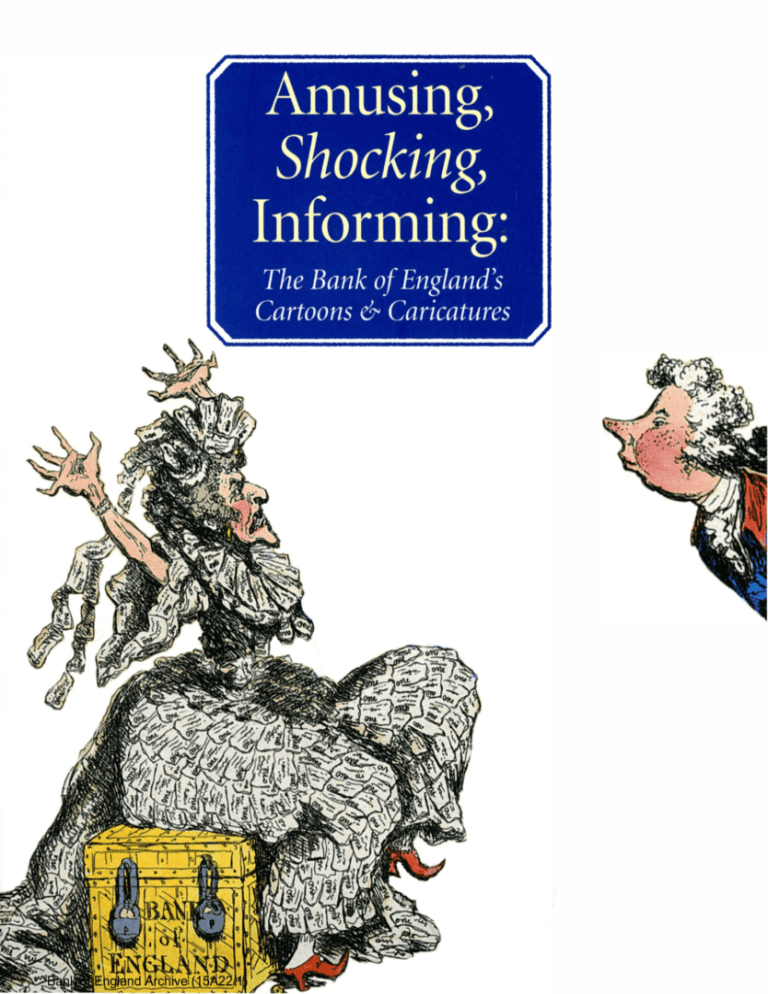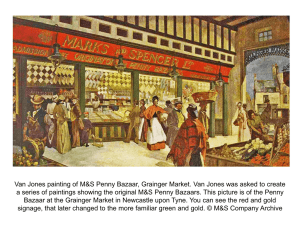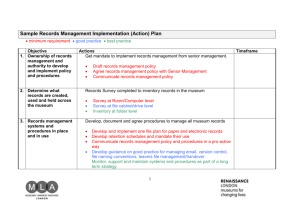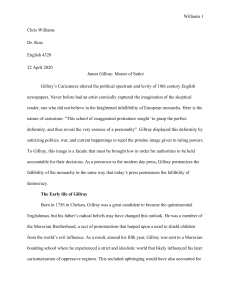Amusing, Shocking, Informing
advertisement

Bank of England Archive (15A22/1)
Bank of England Archive (15A22/1)
T
he fact that the Bank of England possesses
a collection of cartoons and caricatures comes
as a surprise to most people. Indeed, why on
earth would any institution with such a serious central
purpose bother to acquire material which, on the face
of it, merely pokes fun at it? Perhaps it is because
these pieces of art represent an inescapable facet
of the institution's history reflecting as they do the
thoughts, questions, and comments of a particular
time or event.
In 1781 the Prime Minister, Lord North, had described
the Bank as 'a part of the constitution' and by the end
of that century the institution was so well-known that
it was listed in London guide books where it was
described as 'the repository of the nation's wealth'.
Distinguished foreigners, Heads of State and royalty
were conducted round the Threadneedle Street
building - which by 1828 covered three and one half
acres. It was then the largest office building in London
and an object of national pride. With such a high
profile, it is hardly surprising, therefore, that this
keystone of the State did not escape the attention
of the cartoonist and caricaturist.
Although the earliest examples in the collection date
from the first quarter of the 18th century it was not
until fifty years later that, as far as the Bank and its
activities are concerned, the most pertinent specimens
began to appear during what has been described as
the Golden Age of caricature - the period dominated
by the work of James Gillray. And it was on the
22 May 1797, that a cartoon entitled 'Political
Ravishment, or The Old Lady of Threadneedle Street
in danger' went on sale at Mrs Hannah Humphrey's
print shop in St James's. It caused a mild sensation on
the streets and in the clubs of London with its sharp
attack on the actions of the Prime Minister, William
Pitt the Younger. His misuse (or so it was perceived)
of political power to get at the reserves of the Bank
of England, then a privately owned company, was the
subject of fierce debate even though he was acting in
the national interest. The viciously accurate caricature
of the youthful freckled-faced Prime Minister with
his skeletal physique, together with the depiction
of the Bank as an elderly lady was the work of
judgmental, had a point of view and made a point.
They were eagerly purchased by a sniggering or
outraged public. Indeed, a foreign visitor wrote,
in 1802, of the scene outside Gillray's publisher's shop
- "The enthusiasm is indescribable when the next
drawing appears; it is a veritable madness. You have
to make your way through the crowd with your fists."
Even the great and good regarded it as a mark of
acclaim to have suffered at the pen of a consummate
artist such as Gillray. This key cartoon, in which the
Bank is personified as an old lady, gave the earliest
known instance of the Bank's nickname appearing in
print. Since then the Bank of England has almost
always been referred to as 'The Old Lady' and
illustrated as the apotheosis of the maiden aunt with
a nest egg. Well established, secure and prudent she is
the person to go to in a crisis. During the nineteenth
century this image of the Bank was continued by
Sir John Tenniel (1820-1914) although rather earlier
others such as George Cruikshank (1792-1878) with his
Bank Restriction note had launched vitriolic attacks
on the institution blaming it for the sufferings caused
by the Draconian anti-forgery laws. The Old Lady
tradition has been continued although in more recent
years the imagery of an old lady has tended to be
dropped in favour of specific Bank targets. The Bank's
collection of prints and drawings includes examples
of cartoons and caricatures relating to the institution
itself and its denizens, and subjects treated include
paper money; Montagu Norman (whose unprecedent­
edly long term of office as Governor left a distinctive
imprint on the Bank); nationalisation; the Bank's
premises and, more recently, examples of humorous
brush work from Basil Hone and Dennis Denahy,
both former members of staff.
Even more recently the independence given to
the Bank in 1997 to set interest rates through its
Monetary Policy Committee has provided a rich
seam of material which cartoonists and caricaturists
have mined enthusiastically. And so the tradition
which can be said to have been begun by
James Gillray in 1797 has been carried on.
Long may his latter-day successors continue
to amuse, shock and inform.
James Gillray (1757-1815) who is generally regarded as
the greatest of all English caricaturists. Such political
satires with their acidic yet humorous comment
provided much more than today's equivalent visual
image - the television news flash - because they were
2
Bank of England Archive (15A22/1)
II �\! (
!
·L\
\'
\
\
-- -\�- �-\
\
",
.
\
\
..,
The Lottery Adventurers
Pair of engravings. Artist anonymous. Published 1 December 1780
by Robert Wilkinson
A moral comment on lotteries.
Prize:
"One Hand in his Pocket, in t'other a Prize,
What Joy is exprest in this lucky one's Eyes.
0; Fortune, we know, thou'rt a frolicksome jade,
Tho; this you've rais'd high, you've the other betrayd. "
Blank: "How gloomy alas; this poor Fellow is seen
His Luck is sufficient, to give him the spleen.
In chance Work he must deal, like those in high Rank,
He's emptied his Pockets, to buy him a Blank. "
3
Bank of England Archive (15A22/1)
The South Sea Bubble
By William Hogarth. Published 1721
In the mania of speculation which came to be known as the South Sea
Bubble, ordinary, otherwise sane, people became enmeshed in the rush to
invest in a company which had not made any profits but merely promised
them. In this illustration of folly and greed virtues are crimes: Honesty is
broken on the wheel while Honour is whipped before the monument to
the Great Fire which is parodied as a monument to the "destruction of
this city by the South Sea Company". Foolish investors ride on the
whirligig or wheel of fortune (centre) even men of God (bottom left)
are drawn into the gambling mania.
4
Bank of England Archive (15A22/1)
A March to the Bank
By lames Gillray. Published 2 2 nd August 1787
Following an attack on the Bank during the Gordon Riots of 1780
a regular military guard - the Bank Picquet - was instituted.
James Gillray's cartoon satirises the Guard's daily march to the Bank.
Marching two abreast the Picquet jostled from the pavement all who
came in their way. Complaints from the public in 1787 led to the
guard marching in single file.
5
Bank of England Archive (15A22/1)
Substitutes For Bread; Or Right Honourables Saving
the Loaves and Dividing the Fishes
By lames GiLlray. Published 24 December 1795
The lack of sympathy supposed to have been shown by William Pitt
and his Ministers in the year 1795, a year marked by shortages
particularly of wheat, is here satirised as they devour the golden
fish and save the bread. It had been suggested in the House of
Commons that Members should set an example by reducing
their consumption of bread "that more should be left for the
use of the poor".
6
Bank of England Archive (15A22/1)
Opening of the Budget; or John Bull
giving his Breeches to save his Bacon
By lames Gillray. Published 17th November 1796
The continued threat of an invasion by a French
revolutionary army led to heavy taxation in
1796. John Bull representing the British public,
hands over his contribution to the Prime
Minister who holds the budget bag.
Opposite: Midas, Transmuting All
into
� Paper
By lames Gillray. Published 9th March 1797
Having secured access to the Bank's reserves
the Prime Minister, William Piu the Younger
as the legendary King Midas, sits atop the
Bank of England's rotunda turning all he
touches not into gold but into paper.
Bank Notes - Paper Money
- French Alarmists
By lames Gillray. Published 1st March 1797
The Prime Minister, William Piu the
Younger as a Bank teller, pays out paper
money to the public in the shape of John Bull.
Charles James Fox and R B Sheridan
of the Whig opposition attempt to persuade
John Bull that he should insist on gold
rather than accept paper.
7
Bank of England Archive (15A22/1)
8
Bank of England Archive (15A22/1)
Political Ravishment; or The Old Lady of Threadneedle Street in Danger
By lames Gillray. Published 22 May 1797
William Pitt, the Prime Minister, is picking the coin-filled pockets of an old lady
- personi fying the Bank - whose dress is made of fl notes. She is sitting on a locked
money-chest marked Bank of England.
During the Revolutionary Wars against France the Pitt Government had made repeated
demands upon the Bank for gold to pay for the war. Eventually this drain on the Bank's
reserves forced it to suspend payment of its notes in gold in February 1797 and low
denomination notes for fl and £2 were issued for the first time. This cartoon by Gillray
was the first appearance in print - so far as is known - of the Bank's Old Lady nickname.
9
Bank of England Archive (15A22/1)
....•�-"" � : ...../' .........
MENl&_�Er
"1I'EU1L,,�"---­
�.--;;-
, -=--
..
.
�
..
.
m1Jl'ilrAASl!:N.����
The Hand-Writing Upon the Wall
By lames Gillray. Published 24 August 1803
A parody on Belshazzar's Feast. Napoleon Bonaparte,
with Josephine at his side regales his courtiers with a splendid
repast of the spoils of England. The delectable dish in front of him
is entitled " Bank of England". Napoleon had boasted that he needed
only three days of fog to be master of London, of Parliament and
of the Bank of England: however he is found to be wanting and
outweighed by the crown of Louis XVI I I.
10
Bank of England Archive (15A22/1)
Joint Stock Street
By (?) Woodward. Published 10 March 1812
Satire (after the style of Thomas Rowlandson's 'Microcosm of
London') on the mania to invest in joint-stock enterprises. The wall
outside the Hospital for Incurables is littered with advertisements for
such companies which are eagerly perused by a gullible public while
Bubble Alley leads off to the right (Dr Syntax and his companion can
be seen to the left).
.;r6?1'IT4IfLr1drm- 1608
.?.?� ft.JJfJ A1«''Il :nll £;;IXf't.:k
11
Bank of England Archive (15A22/1)
Representation of Ye Gull Trap and Ye Principal Actors In Ye New Farce Called Ye
Hoax - Lately Performed with Great Eclat On Ye S_ X
__
By George Cruikshank. Published 6 April 1814
Lord Cochrane fires a blunderbuss mortally wounding Napoleon with a cannon ball inscribed
"A D [amne] d Lie" while the see-saw balances on the Stock Exchange.
On 21 February 1814 (16 months before Waterloo), stocks rose sharply on the false news of
victory and Napoleon's death. Lord Cochrane and his uncle Cochrane Johnstone together
with another made large profits by selling shares before prices fell when the news could not be
confirmed. Following a Stock Exchange report all those involved were convicted of conspiracy
to defraud. All but Cochrane were undoubtedly guilty.
12
Bank of England Archive (15A22/1)
'Jr JRUE
.
<& liUE A 1r
.B..Ll.NK
!'i
lHL A lL, JL
9
-ENG-LA.N D .
The Great Hall, Bank Of England
By Augustus Pugin and Thomas Rowlandson. Plate 7 to the "Microcosm of London"
Published 1 February 1808
The Great Hall or Pay Hall was the work of the Bank's first architect, George Sampson who
built the first premises in Threadneedle Street in 1734. The Pay Hall stood until the rebuilding
of the Bank (1925-39) by Herbert Baker. Dr Syntax, Rowlandson's ubiquitous figure from the
"Microcosm of London", can be seen in the left foreground. It was to this office that the public
came to exchange notes into coin and coin into notes. The statue of William III by Henry Cheere
which can be seen in the niche at the end of the room, still stands within the Bank.
13
Bank of England Archive (15A22/1)
The Rotunda
Original watercolour by Thomas Rowlandson
The Bank's Rotunda, which was based on the Pantheon in Rome,
was the work of the Bank's second architect, Sir Robert Taylor. It had
been used by brokers and their clients for buying and selling stocks
from the time of its erection in 1765 and even after the first Stock
Exchange had been built in Capel Court in 1801. The busy, slightly
chaotic, scene inside the Rotunda is admirably captured here by
Rowlandson. The brokers were finally excluded on the orders of
the Governor, T A Curtis, in 1838 because of the disruption they had
caused for some years to the work of the Bank's clerks. The ill-feeling
that this engendered resulted in three cheers being called for on the
Exchange on Curtis' bankruptcy in 1841.
14
Bank of England Archive (15A22/1)
Three of a series of cartoons and
sketches drawn by Robert Browning,
the father of the poet
Browning joined the service of the Bank in
1799 and retired fifty years later as Principal
Clerk (manager) of the Bank Stock Office.
Right: A familiar sight in the early 19th
century, a group of visitors being shown
round the Bank.
Below right: Members of the public in the
Bank Stock Office.
Opposite Right: "Advice to the Poor Gratis"
The dispenser of advice bears some
resemblance to Abraham Newland, Chief
Cashier 1778-1807, and a very familiar figure
in the Bank and the City.
15
Bank of England Archive (15A22/1)
'1CWf4'
� d�<&
-zO �A
,zC
�;- -2 '>:Jvr�?7§l?'C�Wu�:
.i�_ � �g�_ �?'-z:.a& ou;C� .�� /'
olf-�-�� �n-$/t?�-d'� on?t?-c.vr-�.
«-
,n..- -=-E-=-'
A P-<�, +- 7��
---4.,�.
/J��I'�,� -r--4L�
Late and Somewhat Unwelcome Stockholder
Withdrawing his Dividends
A
Anon. Inscribed sketched from life
1890
Although the Bank was empowered by an Act of Parliament
of 1869 to post dividends to stockholders the right to collect
them personally continued to be exercised by some well
into the 20th century.
16
Bank of England Archive (15A22/1)
Left: «There's an error here somewhere we'd better say it's seasonally adjusted ...
"
Pen and ink by Ben Shailo (nom -de-plum e
of Basil Hone a m em ber of staff 1943-80)
Eo I. D.
published in The Old Lady, the Bank's quarterly
staff m agazine in March 1978.
GROUP
Two members of the Bank's Economic
Intelligence Department discuss a discrepancy
in their statistics for the Quarterly Bulletin.
Below: A Pride of Gatekeepers Led by
a Head Gatekeeper
By Dennis Denahy a member of staff 1952-92.
Pen and ink. 1990
The Head Gatekeeper's robe and bicorn are
worn and the staff carried on the days that
the Court of Directors, the governing body
of the Bank, meets and on other official
occasions. The robe dates from 1697 whilst
the pink swallow-tailed jacket and red
waistcoat originate from 1791 when a new
rank of Day Porter was created "to assist
the public".
( DI I
--
G�1(eQ(
<;fv-r� N /'tU- �
17
Bank of England Archive (15A22/1)
�
H
lHE
GOVERN
OR
Right: "A perfect example of
unneccessary duplication"
Pen and ink by Basil Hone. Published in
The Old Lady, September 1979
This cartoon was published after the
announcement of the abolition of Exchange
Control, and consequent job losses. The
offices of Governor and Deputy Governor
were created under the 1694 Act which
founded the Bank and continued by
subsequent legislation.
A
P
e It- I Le
UN
18
Bank of England Archive (15A22/1)
Above: 'The Paper Chase'
By Sir John Tenniel. Original pencil drawing of cartoon.
Published in Punch, February 1891
The subject is G J (later Viscount) Goschen, a Director of the
Bank 1858-65 and Chancellor of the Exchequer 1887-92. During
his ministry Goschen advocated the issue of a £I note - the lowest
denomination bank note then in circulation was for £5 - so that
the gold in circulation ie the sovereigns and half-sovereigns might
be put to better use.
Left: "Statesman No. 19"
By "Ape" (Carlo Pellegrini) Lithograph
Published in Vanity Fair, 4 June 1869
George Joachim Goschen
19
Bank of England Archive (15A22/1)
Below: Same Old Game
By Sir John Tenniel. Published 8 November 1890 in Punch
This refers to the Baring crisis of 1890 when, because of unwise
speculation the merchant bank ran into difficulty. The Governor
of the Bank of England, William Lidderdale and the Chancellor
of the Exchequer, GJ Goschen orchestrated a rescue fund of some
£17 million. The crisis was averted but the leading role played by
the Bank demonstrated the responsibility it had come to feel for
the stability of the banking system as a whole.
The Old Lady is depicted with a Bank note in one hand and the
other in a desk drawer. Five small boys stand in front of her, heads
bowed. She is saying: "You've got yourselves into a nice mess with
your precious SPECULATION!! Well I'll help you out of it
- for this once!!"
PUNCH, OR THE LONDON CHARIVARI.-Nov""n.8, 1890.
Above: A Dirty Crossing
By Sir John Tenniel. Original pencil drawing for cartoon.
Published in Punch 13 January 1894
The Bank, represented by an old lady, is depicted crossing the muddy
road of mismanagement exclaiming "Oh dear, oh dear! I wish I were
out of this nasty mess."
The cartoon refers to the discovery of irregularities committed by
the Chief Cashier, Frank May. Although his misdemeanours were
unactionable they resulted in losses to the Bank whose system of
checks and balances had been found to be wanting. The upshot
was the establishment in 1894 of the Audit Department.
OLD LADY
OF
Txu.DIIUDLJ! BuUT.
'SPBCUL.J.TION!'
"SAME OLD GAME!"
.. YOU'VE GOT YOURBELVE9 INTO
WELL-I'LL HELP YOU OUT
A NlOE 1oIE98 WITH YOUR
DE' IT,-FOR THIS ONOB!!"
PltECIOUS
20
Bank of England Archive (15A22/1)
Below: Nil Desperandum
By C F Greatbach. Drawing in ink.
Published in The Dark Horse
Craftsman:
"Oy you blokes! Ars longa vita brevis
I'd ave you remember; if you don't get
Back 011 the j ob, there'll be no quid
Pro quo on Friday !light."
This cartoon refers to an error in the spelling of the Latin inscription
on a coin illustrated in the mosaic floor in a corridor of the Bank in
1933. The Bank was completely rebuilt between 1925 and 1939.
The mosaic floors were laid by Boris Anrep, a renowned mosaicist,
whose work can be seen in the National Gallery and Westminster
Cathedral.
l
Top: Montagu Norman
By Derso et Kelen. Ink sketch
Thought to be a preliminary sketch done
by Derso et Kelen for a large cartoon of
various financial personalities of the 1930S.
It is autographed by Montagu Norman.
Above: The Governor
Coloured lithograph. Published 18 September
1935 in Punch as No 12 of a series entitled
"People in Punch"
Montagu Norman (Governor 1920-1944)
seated on the statue of the Old Lady on the
Threadneedle Street portico of the Bame
21
Bank of England Archive (15A22/1)
---­
SIR
CUNl�FE
S�\NNE-'R
DR.
-
�
o_
��
NEYILLE
�I
SK'INNER
\ ;V
III 6;y �
lY � u :/J
�
�
PRofESSOR
S,ANLE't
SKINNER.
(
"HE.
SKINNER TAM\Ly.
1--( 1'5 UN'REUABlY 'RE?O�-rED -n-\A-r OWING 10 -(H£ DoVBi Or -(H£\'Q.. 'REQ..EPY,DN. l'ttt:
O,-(I"AWA PELEGAIES p.:Rt. -(RAV\::"LLlN
A<S �ELAI'\UNS. o"F tvl12 MQN,AGV NO"RMA-N ,W\+O
t-\\IV\SEL""F IS. -(RAVE:.LLlNG- AS 'PRor=-E.'SsoR Cl..A'RE.;NCE. 'S.'(("INNE.'I-<..- NE-W'.S,.
l-(clV\.) .
Above: The Skinner Family
Cartoon by Strube, 1932
Delegates of the British Government to the Imperial Conference at Ottawa in 1932 are shown
on board the "Empress of Britain". The caption refers to Montagu Norman's practice of
travelling abroad under the name of Professor Clarence Skinner.
Those on deck are The Rt Hon Waiter Skinner (Waiter Runciman, President of the Board of
Trade), Mr Hailsham Skinner (Viscount Hailsham, Secretary of War), Sir Cunliffe Skinner
(Sir Philip Cunliffe - Lister, Colonial Secretary), Dr Neville Skinner (Neville Chamberlain,
Chancellor of the Exchequer), Professor Stanley Skinner (Stanley Baldwin, Lord President)
and J H Skinner (J H Thomas, Dominions Secretary).
Bank of England Archive (15A22/1)
Not This Time
By Bernard Partridge. Pen and ink drawing.
Published 20 November 1935 in Punch
Citizen Attlee is saying to the Old Lady of
Threadneedle Street: «Cab, lady?" The
«cab" is in fact a tumbril with a banner
proclaiming «Nationalisation of Banks".
There is a signpost - «To the Guillotine".
In a speech made at Accrington on 13
October 1935, Clement Attlee, the leader
of the Labour Party, said: «If the Labour
Party resumed power the first thing they
would invade would be the «Temple of
the Golden Calf " in Threadneedle Street
- the Bank of England. In the period
between the speech and the publication
N'OT
THiS
TIMt. �
"Cb,
c.it(�tl\ J\ttlee (to fu Old �.Y"fTlrudneedle Strc�t):
23
Bank of England Archive (15A22/1)
of the cartoon, a general election had been
la?;?"
['k""h/. {aJy ?J
held at which the National Government,
dominated by the Conservatives, had
been returned with a large majority.
Left: Pas De Deux
By E H Shepard. Published in Punch
30 January 1 946
The Bank and the Coal Industry skate
on the frozen pond of nationalisation
with the comment "I wonder what sort
of figure we old people are going to cut."
Both were nationalised in 1946.
PAS
Cl 1 wonder what
50[[
DE DEUX
of figure wc old people
act
going to
cut,"
Right: So much for Nationalisation
----
By Joseph Lee. Pen and ink drawing. Published
13 March 1946 in The Evening News
The cartoon depicts a tramp being ejected from the Bank
of England and exclaiming "So much for nationalisation.
This is wot 'appens when one
0'
the OWNERS asks for a few
quid till Friday."
The Bank of England was nationalised on 1 March 1946.
> "",.,j;?r AI4;',,".il!;�.
�
7£ Ij �;' -r!"!"s ..1411
"""
, 'It N.1i0
...I!?r.9/rvr/dl ,.-5;+ . /�0\)
24
Bank of England Archive (15A22/1)
" i
h'l '
Bank Restriction Note
By
George Cruikshank 1819
This grim parody of a Bank of England note was drawn by
Cruikshank as a protest against the severity of the anti-forgery laws.
It is decorated with skulls, gibbets and a hangman's noose and signed
by Jack Ketch, the public executioner. The forging of Bank of England
notes remained a capital offence until 1832.
25
Bank of England Archive (15A22/1)
One Pound
By Nicholas Garland. Pen and ink sketch.
Published 13 November 1984 in The Daily
Telegraph
An apple (Nigel Lawson, Chancellor of the
Exchequer) bounces on the head of Sir Isaac
Newton pictured on the back of the £1 note.
Published following the announcement on
12 November 1984 of the end of the £1 note.
26
Bank of England Archive (15A22/1)
The Men of Paper Going To Pot; Or, the Directors in a Stew
Anonymous. Coloured etching. Published 22 June 1819 by T Tegg
The Directors of the Bank in a large cauldron on a fire which is
being stoked with paper money. It reflects the supposed alarm
within the Bank at this time at being compelled under Peel's
Currency Bill of 1819 gradually to resume cash payments which
had been suspended since 1797.
27
Bank of England Archive (15A22/1)
The Men of Paper Going To Pot;
Or, the Directors in a Stew
By Richard Cole. Published in The Daily
Telegraph 24 March 1997
The men of paper, Prime Minister,
John Major and Chancellor of the
Exchequer, Kenneth Clarke, overseeing
the stoking of the fires of inflation to
the severe discomfiture of those in the
cauldron - Governor Eddie George
and his deputy Howard Davies.
A Peep into the Old Rag Shop
in Threadneedle Street
Anonymous. Coloured engraving.
Published 28 September 1818
by S W Fares, 50 Piccadilly
;;��/J.r1
"
!
hloJ;.,b4&b,/ ."
I ""I'�II' /hM ,-i t-v ?tU/do
I
t-, ,J.',/�::�.,�:'-"�;T ::::
'
/;'< &".,7
An unfortunate man, accompanied by
friends or relations, is being dragged
before a Committee of the Bank's
Directors on a charge of forging a
Bank note or having a forged note
in his possession.
The passing of forged notes was a crime
that carried the death penalty until 1832
and several hundred people were executed.
However, it was said that the quality of
the Bank's notes was so poor that even
the Bank were sometimes unable to
detect the difference between genuine
notes and forgeries.
28
Bank of England Archive (15A22/1)
Untitled
By Dave Brown. Published in The Sunday Times 30 May 1993
The then Deputy Governor, Eddie George, at the helm of The Old
Lady lifeboat steers through troubled waters. The wreckage of BCC!
can be seen in the distance.
29
Bank of England Archive (15A22/1)
) CTYr\e P ers CTM li-ties
Untitled
By Steve Bell. Published in The Guardian 16 September 1998
In 1998 Eddie George addressed the Trades Union Congress. He was
the first Governor of the Bank of England to do so. The expectation
was that he would be less than enthusiastically received. In the event
he was courteously heard and politely applauded.
30
Bank of England Archive (15A22/1)
Make up your mind time? That's strictly for the birds
By Richard Cale. Published in The Daily Telegraph 16 August 1998
The publication of the minutes of the Bank's Monetary Policy
Committee. Members of the Bank's Monetary Policy Committee
are here depicted as birds and an animal. The Committee's
minutes are published monthly, two weeks after each meeting.
31
Bank of England Archive (15A22/1)
The Bank Slips Its Lead.
By Richard Cale. Published in The Sunday Telegraph 11 May 1997
The Governor, Eddie George, is depicted as a bulldog being let
off the leash by the Chancellor of the Exchequer, Gordon Brown.
This refers to the announcement by the Government in May 1997
that the Bank now had independence to set interest rates.
32
Bank of England Archive (15A22/1)
Amusing, Shocking, Informing:
The Bank of England's Cartoons
& Caricatures
At The Bank of England Museum
7 April to 5 October 2000
Curator of the Museum
Acknowledgements
Page 17
Page 18
Basil Hone
Page 23 & 24
Reproduced with
Page 26
Exhibition & Graphic Design
H Design
Co-ordination
Lorraine Painter
Maureen Pickston
assisted by Lynn Austin
June Greenhalf
and Claire Watson-Bardot
Display Mounting
Plowden & Smith
Rex Poland
Photography
Heini Schneebeli
Photographic Displays
Photolab Techniques
Printing
Excelprint
Booklet Text
John Keyworth
33
Bank of England Archive (15A22/1)
permission of Punch Ltd
© Copyright
Daily Telegraph 1984
John Keyworth
TU
Basil Hone
and Dennis Denahy
Page 28
© Copyright Richard Cole
Page 29
© Copyright Dave Brown
Page 30
© Copyright Steve Bell
Page 31 & 32
© Copyright Richard Cole
Front cover:
Detail f ro m Political Ravishment;
or The Old Lady of Threadneedle Street
in Danger By lames Gillray. Published
22 May 1797 (see page 8)
Inside front and back cover:
The Threadneedle Street Frontage
of the Bank By Charles Laborde c.1928
Bank of England Archive (15A22/1)
Bank of England Museum, Bartholomew Lane, London EC2R 8AH
Bank of England Archive (15A22/1)



![University Archive Rules and Visitor Book [Word]](http://s3.studylib.net/store/data/007461955_1-a66c84ca7724fc8dd4fb6b700fffcb7c-300x300.png)


